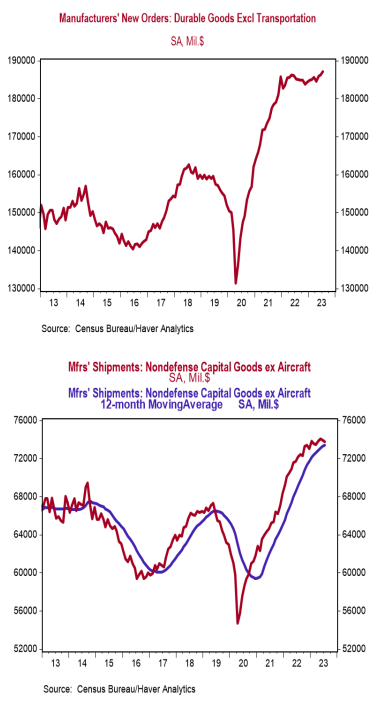- New orders for durable goods fell 5.2% in July (-5.3% including revisions to prior months), lagging the consensus expected -4.0%. Orders excluding transportation rose 0.5% (+0.2% including revisions), versus a consensus expected +0.2%. Orders are up 3.8% from a year ago, while orders excluding transportation have risen 1.1%.
- A steep decline in orders for commercial aircraft was partially offset by gains across most other major categories.
- The government calculates business investment for GDP purposes by using shipments of non-defense capital goods excluding aircraft. That measure fell 0.2% in July. If unchanged in August and September, these shipments will be down at a 0.8% annualized rate in Q3 versus the Q2 average.
- Unfilled orders rose 0.5% in July and are up 6.6% in the past year.
Implications:
A mixed bag for durable goods in July, as transportation orders continue to muddle the headline readings, but orders in core categories continue to trudge higher. Orders for commercial aircraft plummeted 43.6% in July after soaring 71.1% in June. But strip out the typically volatile transportation category and orders rose a moderate 0.5% in July (+0.2% including revisions to prior months), with gains across most major categories. Machinery led ex-transportation orders higher, rising 1.1% in July, while electrical equipment (+1.0%) and fabricated metal products (+0.7%) also rose. Computer and electronic products was the lone major category to decline, albeit only 0.1%. Arguably the most important number in today’s report is core shipments – a key input for business investment in the calculation of GDP – which slipped 0.2% in July. If unchanged in August and September, core shipments would decline at a 0.8% annualized rate in Q3 vs the Q2 average and detract from economic growth for the first time since Q2 of 2020. Core shipment growth has been slowing since the start of 2022, and we expect that this tempering will continue as the economy feels the lagged effects of the Federal Reserve’s actions to remove money from the system. In the past year, orders for durable goods are up 3.8%, while orders excluding transportation are up more modest 1.1%. But when you consider that producer prices for capital equipment are up 4.2% in the past year, it means that orders have declined when adjusted for inflation. A number of factors are likely to keep the path forward rocky as we continue further into 2023: a tighter Federal Reserve, the tightening of lending standards following stress in the banking sector, and withdrawal symptoms following the COVID-era economic morphine that artificially boosted both consumer and business spending. In addition, the return toward services means a large portion of goods-related activity will soften in the year ahead, even as some durables that facilitate services recover. While the data to-date have shown continued economic growth, we believe a recession awaits us starting late this year or in 2024. In employment news this morning, initial claims for jobless benefits fell 10,000 last week to 230,000, while continuing claims fell 9,000 to 1.702 million. These figures suggest continued job growth in August.





